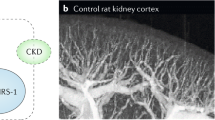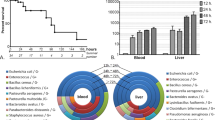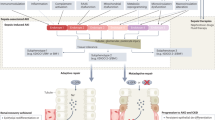Abstract
Cholestasis is a common complication in patients with extrahepatic bacterial infection and sepsis. This article gives a comprehensive overview of the molecular and cellular mechanisms of sepsis-associated cholestasis. Recent advances in the understanding of intrahepatic cholestasis have allowed us to delineate the molecular mechanisms that underlie sepsis-associated cholestasis and to describe their potential clinical and therapeutic applications. The mechanisms and clinical presentation of sepsis-associated liver injury vary according to the severity of the bacterial infection. Proinflammatory cytokines and nitric oxide cause cholestasis by impairing hepatocellular and ductal bile formation. Ischemic liver injury and, rarely, progressive sclerosing cholangitis can also be found in patients with septic shock, or major trauma with systemic inflammatory response syndrome. Treatment is mainly focused on eradication of the underlying infection and managing the sepsis. The use of ursodeoxycholic acid or extracorporeal liver support as treatments for sepsis-associated cholestasis is under investigation, but neither can be recommended in routine clinical practice at present. Patients with progressive sclerosing cholangitis should be considered for orthotopic liver transplantation.
Key Points
-
Cholestasis is a common complication in patients with extrahepatic bacterial infection and sepsis, predominantly associated with Gram-negative bacteria
-
Cholestasis in sepsis results from either a functional defect in bile formation at the hepatocellular level or an impairment in bile secretion at the level of the small or large bile ducts caused by proinflammatory cytokines and nitric oxide
-
The clinical presentation of sepsis-associated liver injury varies according to the severity of the bacterial infection
-
Functional hepatocellular cholestasis (sepsis-associated cholestasis) predominates in patients with sepsis, whereas ischemic liver injury (shock liver) and, occasionally, progressive sclerosing cholangitis can be found in patients with septic shock or major trauma with systemic inflammatory response syndrome
-
Treatment is focused mainly on eradicating the underlying infection and managing the sepsis
-
Patients with progressive sclerosing cholangitis should be considered for orthotopic liver transplantation
This is a preview of subscription content, access via your institution
Access options
Subscribe to this journal
Receive 12 print issues and online access
$209.00 per year
only $17.42 per issue
Buy this article
- Purchase on Springer Link
- Instant access to full article PDF
Prices may be subject to local taxes which are calculated during checkout




Similar content being viewed by others
References
Bone RC et al. (1992) Definitions for sepsis and organ failure and guidelines for the use of innovative therapies in sepsis. The ACCP/SCCM Consensus Conference Committee, American College of Chest Physicians/Society of Critical Care Medicine. Chest 101: 1644–1655
Lolis E and Bucala R (2003) Therapeutic approaches to innate immunity: severe sepsis and septic shock. Nat Rev Drug Discov 2: 635–645
Dhainaut JF et al. (2001) Hepatic response to sepsis: interaction between coagulation and inflammatory processes. Crit Care Med 29 (Suppl): S42–S47
Trauner M et al. (1999) Inflammation-induced cholestasis. J Gastroenterol Hepatol 14: 946–959
Moseley R (1997) Sepsis-associated cholestasis. Gastroenterology 112: 302–306
Martin GS et al. (2003) The epidemiology of sepsis in the United States from 1979 through 2000. N Engl J Med 348: 1546–1554
Whitehead MW et al. (2001) The causes of obvious jaundice in South West Wales: perceptions versus reality. Gut 48: 409–413
Pastores SM et al. (1996) Splanchnic ischemia and gut mucosal injury in sepsis and the multiple organ dysfunction syndrome. Am J Gastroenterol 91: 1697–1710
Trauner M et al. (1998) Molecular pathogenesis of cholestasis. N Engl J Med 339: 1217–1227
Benninger J et al. (2005) Sclerosing cholangitis following severe trauma: description of a remarkable disease entity with emphasis on possible pathophysiologic mechanisms. World J Gastroenterol 11: 4199–4205
Engler S et al. (2003) Progressive sclerosing cholangitis after septic shock: a new variant of vanishing bile duct disorders. Gut 52: 688–693
Trauner M and Boyer JL (2003) Bile salt transporters: molecular characterization, function, and regulation. Physiol Rev 83: 633–671
Seward DJ et al. (2003) Functional complementation between a novel mammalian polygenic transport complex and an evolutionarily ancient organic solute transporter, OSTα–OSTβ. J Biol Chem 278: 27473–27482
Boyer JL et al. (2006) Up-regulation of a basolateral FXR-dependent bile acid efflux transporter, OSTα–OSTβ, in cholestasis in humans and rodents. Am J Physiol Gastrointest Liver Physiol 290: G1124–G1130
Strazzabosco M et al. (2005) Pathophysiology of cholangiopathies. J Clin Gastroenterol 39 (Suppl 2): S90–S102
Karpen SJ (2002) Nuclear receptor regulation of hepatic function. J Hepatol 36: 832–850
Eloranta JJ and Kullak-Ublick GA (2005) Coordinate transcriptional regulation of bile acid homeostasis and drug metabolism. Arch Biochem Biophys 433: 397–412
Arrese M and Trauner M (2003) Molecular aspects of bile formation and cholestasis. Trends Mol Med 9: 558–564
Trauner M et al. (1999) Molecular regulation of hepatocellular transport systems in cholestasis. J Hepatol 31: 165–178
Moseley RH (2004) Sepsis and cholestasis. Clin Liver Dis 8: 83–94
Crawford JM (1997) Cellular and molecular biology of the inflamed liver. Curr Opin Gastroenterol 13: 175–185
Luster MI et al. (1994) Endotoxin-induced cytokine gene expression and excretion in the liver. Hepatology 19: 480–488
Sewnath ME et al. (2002) Interleukin-1 receptor type I gene-deficient bile duct-ligated mice are partially protected against endotoxin. Hepatology 35: 149–158
Lazaridis KN et al. (2004) The cholangiopathies: disorders of biliary epithelia. Gastroenterology 127: 1565–1577
Fong YM et al. (1990) The acute splanchnic and peripheral tissue metabolic response to endotoxin in humans. J Clin Invest 85: 1896–1904
Roelofsen H et al. (1995) Impaired hepatocanalicular organic anion transport in endotoxemic rats. Am J Physiol 269: G427–G434
Whiting JF et al. (1995) Tumor necrosis factor-alpha decreases hepatocyte bile salt uptake and mediates endotoxin-induced cholestasis. Hepatology 22: 1273–1278
Blaschke TF et al. (1973) Effects of induced fever on sulfobromophthalein kinetics in man. Ann Intern Med 78: 221–226
Jones A et al. (1990) Tumour necrosis factor, cholestatic jaundice, and chronic liver disease. Gut 31: 938–939
Trauner M et al. (2005) Molecular regulation of hepatobiliary transport systems: clinical implications for understanding and treating cholestasis. J Clin Gastroenterol 39 (Suppl 2): S111–S124
Ring A and Stremmel W (2000) The hepatic microvascular responses to sepsis. Semin Thromb Hemost 26: 589–594
Hirata K et al. (2001) Sepsis and cholestasis: basic findings in the sinusoid and bile canaliculus. J Hepatobiliary Pancreat Surg 8: 20–26
Bateman RM et al. (2003) Bench-to-bedside review: microvascular dysfunction in sepsis—hemodynamics, oxygen transport, and nitric oxide. Crit Care 7: 359–373
Sherlock S (1987) The syndrome of disappearing intrahepatic bile ducts. Lancet 2: 493–496
Trauner M (2003) When bile ducts say NO: the good, the bad, and the ugly. Gastroenterology 124: 847–851
Trauner M et al. (1997) Nitric oxide donors stimulate bile flow and glutathione disulfide excretion independent of guanosine 3',5'-cyclic monophosphate in the isolated perfused rat liver. Hepatology 25: 263–269
Myers NC et al. (1996) cGMP stimulates bile acid-independent bile formation and biliary bicarbonate excretion. Am J Physiol 270 (Pt 1): G418–G424
Dufour JF et al. (1995) Nitric oxide blocks bile canalicular contraction by inhibiting inositol trisphosphate-dependent calcium mobilization. Gastroenterology 108: 841–849
Burgstahler AD and Nathanson MH (1995) NO modulates the apicolateral cytoskeleton of isolated hepatocytes by a PKC-dependent, cGMP-independent mechanism. Am J Physiol 269 (Pt 1): G789–G799
Spirli C et al. (2003) Cytokine-stimulated nitric oxide production inhibits adenylyl cyclase and cAMP-dependent secretion in cholangiocytes. Gastroenterology 124: 737–753
Denson LA et al. (2000) Interleukin-1β suppresses retinoid transactivation of two hepatic transporter genes involved in bile formation. J Biol Chem 275: 8835–8843
Karpen SJ et al. (1996) Multiple factors regulate the rat liver basolateral sodium-dependent bile acid co-transporter gene promoter. J Biol Chem 271: 15211–15221
Trauner M et al. (1998) Endotoxin down-regulates rat hepatic Ntcp gene expression by decreased activity of critical transcription factors. J Clin Invest 101: 2092–2100
Zollner G et al. (2002) Induction of short heterodimer partner 1 precedes downregulation of Ntcp in bile duct-ligated mice. Am J Physiol Gastrointest Liver Physiol 282: G184–G191
Geier A et al. (2005) Cytokine-dependent regulation of hepatic organic anion transporter gene transactivators in mouse liver. Am J Physiol Gastrointest Liver Physiol 289: G831–G841
Lund M et al. (1999) Effects of LPS on transport of indocyanine green and alanine uptake in perfused rat liver. Am J Physiol 277 (Pt 1): G91–G100
Cherrington NJ et al. (2004) Lipopolysaccharide-mediated regulation of hepatic transporter mRNA levels in rats. Drug Metab Dispos 32: 734–741
Zollner G et al. (2001) Hepatobiliary transporter expression in percutaneous liver biopsies of patients with cholestatic liver diseases. Hepatology 33: 633–646
Geier A et al. (2003) Effects of proinflammatory cytokines on rat organic anion transporters during toxic liver injury and cholestasis. Hepatology 38: 345–354
Lee JM and Boyer JL (2000) Molecular alterations in hepatocyte transport mechanisms in acquired cholestatic liver disorders. Semin Liver Dis 20: 373–384
Zollner G et al. (2003) Adaptive changes in hepatobiliary transporter expression in primary biliary cirrhosis. J Hepatol 38: 717–727
Lee JM et al. (2000) Expression of the bile salt export pump is maintained after chronic cholestasis in the rat. Gastroenterology 118: 163–172
Trauner M et al. (1997) The rat canalicular conjugate export pump (Mrp2) is down-regulated in intrahepatic and obstructive cholestasis. Gastroenterology 113: 255–264
Elferink MG et al. (2004) LPS-induced downregulation of MRP2 and BSEP in human liver is due to a post-transcriptional process. Am J Physiol Gastrointest Liver Physiol 287: G1008–G1016
Vos TA et al. (1998) Up-regulation of the multidrug resistance genes Mrp1 and Mdr1b, and down-regulation of the organic anion transporter, Mrp2, and the bile salt transporter, Spgp, in endotoxemic rat liver. Hepatology 28: 1637–1644
Jansen PL and Muller M (1999) Early events in sepsis-associated cholestasis. Gastroenterology 116: 486–488
Haussinger D et al. (2000) Short-term regulation of canalicular transport. Semin Liver Dis 20: 307–321
Kubitz R et al. (1999) Regulation of the multidrug resistance protein 2 in the rat liver by lipopolysaccharide and dexamethasone. Gastroenterology 116: 401–410
Kuhlkamp T et al. (2005) Degradation of the sodium taurocholate cotransporting polypeptide (NTCP) by the ubiquitin-proteasome system. Biol Chem 386: 1065–1074
Han X et al. (2004) Increased iNOS activity is essential for hepatic epithelial tight junction dysfunction in endotoxemic mice. Am J Physiol Gastrointest Liver Physiol 286: G126–G136
De Maio A et al. (2000) Interruption of hepatic gap junctional communication in the rat during inflammation induced by bacterial lipopolysaccharide. Shock 14: 53–59
Gonzalez HE et al. (2002) Regulation of hepatic connexins in cholestasis: possible involvement of Kupffer cells and inflammatory mediators. Am J Physiol Gastrointest Liver Physiol 282: G991–G1001
Spirli C et al. (2001) Proinflammatory cytokines inhibit secretion in rat bile duct epithelium. Gastroenterology 121: 156–169
Scheppach W et al. (2001) Sclerosing cholangitis and liver cirrhosis after extrabiliary infections: report on three cases. Crit Care Med 29: 438–441
Trauner M and Boyer JL (2004) Cholestatic syndromes. Curr Opin Gastroenterol 20: 220–230
Fickert P et al. (2002) Ursodeoxycholic acid aggravates bile infarcts in bile duct-ligated and Mdr2 knockout mice via disruption of cholangioles. Gastroenterology 123: 1238–1251
Quale JM et al. (1988) Clinical significance and pathogenesis of hyperbilirubinemia associated with Staphylococcus aureus septicemia. Am J Med 85: 615–618
Lefkowitch JH (1982) Bile ductular cholestasis: an ominous histopathologic sign related to sepsis and “cholangitis lenta”. Hum Pathol 13: 19–24
Gossard AA et al. (2005) Secondary sclerosing cholangitis: a comparison to primary sclerosing cholangitis. Am J Gastroenterol 100: 1330–1333
Strassburg CP (2003) Gastrointestinal disorders of the critically ill. Shock liver. Best Pract Res Clin Gastroenterol 17: 369–381
Seeto RK et al. (2000) Ischemic hepatitis: clinical presentation and pathogenesis. Am J Med 109: 109–113
Johnson RD et al. (1995) Extreme serum elevations of aspartate aminotransferase. Am J Gastroenterol 90: 1244–1245
Henrion J et al. (2003) Hypoxic hepatitis: clinical and hemodynamic study in 142 consecutive cases. Medicine (Baltimore) 82: 392–406
Gibson PR and Dudley FJ (1984) Ischemic hepatitis: clinical features, diagnosis and prognosis. Aust NZ J Med 14: 822–825
Rivers E et al. (2001) Early goal-directed therapy in the treatment of severe sepsis and septic shock. N Engl J Med 345: 1368–1377
Annane D et al. (2005) Septic shock. Lancet 365: 63–78
Bochud PY et al. (2004) Antimicrobial therapy for patients with severe sepsis and septic shock: an evidence-based review. Crit Care Med 32 (Suppl): S495–S512
Bode KA et al. (2002) Inhibition of transport across the hepatocyte canalicular membrane by the antibiotic fusidate. Biochem Pharmacol 64: 151–158
Dietrich CG et al. (2003) ABC of oral bioavailability: transporters as gatekeepers in the gut. Gut 52: 1788–1795
Paumgartner G and Beuers U (2002) Ursodeoxycholic acid in cholestatic liver disease: mechanisms of action and therapeutic use revisited. Hepatology 36: 525–531
Paumgartner G and Beuers U (2004) Mechanisms of action and therapeutic efficacy of ursodeoxycholic acid in cholestatic liver disease. Clin Liver Dis 8: 67–81
Beuers U (2006) Drug insight: mechanisms and sites of action of ursodeoxycholic acid in cholestasis. Nat Clin Pract Gastroenterol Hepatol 3: 318–328
Fickert P et al. (2001) Effects of ursodeoxycholic and cholic acid feeding on hepatocellular transporter expression in mouse liver. Gastroenterology 121: 170–183
Zollner G et al. (2003) Role of nuclear bile acid receptor, FXR, in adaptive ABC transporter regulation by cholic and ursodeoxycholic acid in mouse liver, kidney and intestine. J Hepatol 39: 480–488
Marschall HU et al. (2005) Complementary stimulation of hepatobiliary transport and detoxification systems by rifampicin and ursodeoxycholic acid in humans. Gastroenterology 129: 476–485
Trauner M and Graziadei IW (1999) Review article: mechanisms of action and therapeutic applications of ursodeoxycholic acid in chronic liver diseases. Aliment Pharmacol Ther 13: 979–996
Keh D and Sprung CL (2004) Use of corticosteroid therapy in patients with sepsis and septic shock: an evidence-based review. Crit Care Med 32 (Suppl): S527–S533
Annane D et al. (2002) Effect of treatment with low doses of hydrocortisone and fludrocortisone on mortality in patients with septic shock. JAMA 288: 862–871
Sen S et al. (2005) Emerging indications for albumin dialysis. Am J Gastroenterol 100: 468–475
Acknowledgements
This work was supported by grants from the Deutsche Forschungsgemeinschaft SFB542 TP C1 (to A Geier) and by grant P18613-B05 from the Austrian Science Fund, grant 10266 from the Jubilee Funds of the Austrian National Bank and a GEN-AU grant from the Austrian Ministry for Science (to M Trauner).
Author information
Authors and Affiliations
Corresponding author
Ethics declarations
Competing interests
The authors declare no competing financial interests.
Rights and permissions
About this article
Cite this article
Geier, A., Fickert, P. & Trauner, M. Mechanisms of Disease: mechanisms and clinical implications of cholestasis in sepsis. Nat Rev Gastroenterol Hepatol 3, 574–585 (2006). https://doi.org/10.1038/ncpgasthep0602
Received:
Accepted:
Issue Date:
DOI: https://doi.org/10.1038/ncpgasthep0602
This article is cited by
-
Liver damage profile in COVID-19 pregnant patients
Cell Communication and Signaling (2024)
-
Risks of digestive diseases in long COVID: evidence from a population-based cohort study
BMC Medicine (2024)
-
Bile acids profile and redox status in healthy infants
Pediatric Research (2023)
-
Gestational age-specific clinical correlates of acute kidney injury in preterm infants with necrotizing enterocolitis
Pediatric Research (2023)
-
The liver in sepsis: molecular mechanism of liver failure and their potential for clinical translation
Molecular Medicine (2022)



